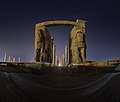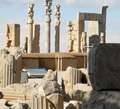Gate of All Nations
The Gate of All Nations (Old Persian : duvarthim visadahyum) also known as the Gate of Xerxes, is located in the ruins of the ancient city of Persepolis, Iran.
| Gate of All Nations | |
|---|---|
_in_Persepolis.tif.jpg) View of the Gate of All Nations palace | |
| Religion | |
| Province | Fars province |
| Region | 70 km northeast of the modern city of Shiraz in the Fars Province of modern Iran |
| Location | |
| Location | |
| Municipality | Marvdasht |
| State | Marvdasht |
| Sector | Persepolis |
| Territory | Iran |
| Geographic coordinates | 29.934444°N 52.891389°E |
| Architecture | |
| Type | Achaemenid architecture |
| Materials | stone |
| Website | |
| https://whc.unesco.org/en/list/114 | |
The construction of the Stairs of All Nations and the Gate of All Nations was ordered by the Achaemenid king Xerxes I (486-465 BC), the successor of the founder of Persepolis, Darius I the Great.[1]
Building
The structure consisted of one large room whose roof was supported by four stone columns with bell-shaped bases. Parallel to the inner walls of this room ran a stone bench, interrupted at the doorways. The outside walls, made of broad mud block, were bedecked with frequent niches. Each of the three walls, on the east, west, and south, had a very large stone doorway. A pair of massive bulls secured the western entrance; two Lamassu in the Assyrian style, albeit, of colossal proportions, stood at the eastern doorway. Engraved above each of the four colossi is a trilingual inscription attesting to Xerxes having built and fulfilled the gate. The doorway on the south, opening toward the Apadana, is the widest of the three. Pivoting devices found on the inner corners of all the doors indicate that they must have had two-leaved doors, which were possibly made of wood and covered with sheets of ornamented metal.
Gallery
 View of front
View of front- View with visitors








References
- "Gate of All Nations". Archived from the original on 2014-03-07. Retrieved 2014-02-16.
External links

- Gate of Xerxes
- The Gate of All Nations at Wikimapia
- The Grand Stairway and the Gate of All Nations
- Shiraz Persepolis
- Persepolis: Gate of All Nations

